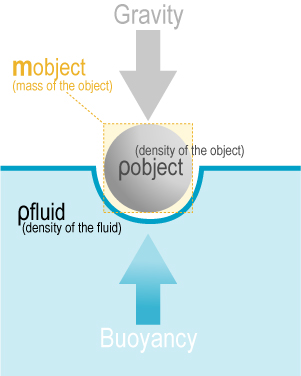Buoyancy is an extremely important aspect of diving, without it, one would just become another rock at the bottom of the ocean; clearly not a desired location. We have to thank Archimedes, an ancient Greek mathematician and inventor, for discovering how buoyancy works. Essentially Archimedes Principle states: "that any body completely or partially submerged in a fluid (gas or liquid) at rest is acted upon by an upward, or buoyant, force the magnitude of which is equal to the weight of the fluid displaced by the body" (britannica).
A simple equation for Archimedes principle is:
the buoyancy of a submerged body = weight of displaced liquid – weight of the body
From this equation we can conlude the following:
1. The body will float--if the buoyancy is positive
2.The body will sink--if the buoyancy is negative
3.The body will be stuck--if the buoyancy is neutral
(the physics of diving)
 (Buoyancy)
(Buoyancy)The buoyant force of a liquid depends on its density, its weight per unit of volume. The density of freshwater is 62.4 pounds per cubic foot (28.3 kg/ 0.03 m3) and the density of seawater is 64 pounds per cubic foot (29 kg/0.03 m3) which is denser than freshwater; hence why people float better in seawater than in fresh.
Individual bodies have aspects that can also contribute to their buoyancy. Lung capacity is a contributing factor. A diver with lungs full of air displaces a larger volume. According to Archimedes principle, they would be more buoyant than a person with deflated lungs. Bone structure, bone weight and body fat are also factors.
When diving, a diver must be able to control his or her buoyancy. The two most important factors of a diver's bouyancy are the diver's total weight versus the amount of air in a diver's lungs and in their BCD (Bouyancy control device). The diver's total weight depends on their body weight, the weight of their gear and any additional weight they must add in order to achieve a correct weight to bouyancy ratio. Divers can control the amount of weight they carry by wearing a weight belt or by inserting lead weights into their BCD. Without the aid of weights, a diver would almost always be unable to descend without expending a great deal of energy. The air in a diver's lungs can be controlled by simply inhaling or exhaling. The air in the BCD is controlled through a valve that adds air to the BCD from the air tank and a seperate valve that purges air from the BCD into the surrounding water. In addition, a diver must add additional weight at the start of their dive to compensate for the weight that will be lost from their air tank as air is consumed throughout the course of the dive.